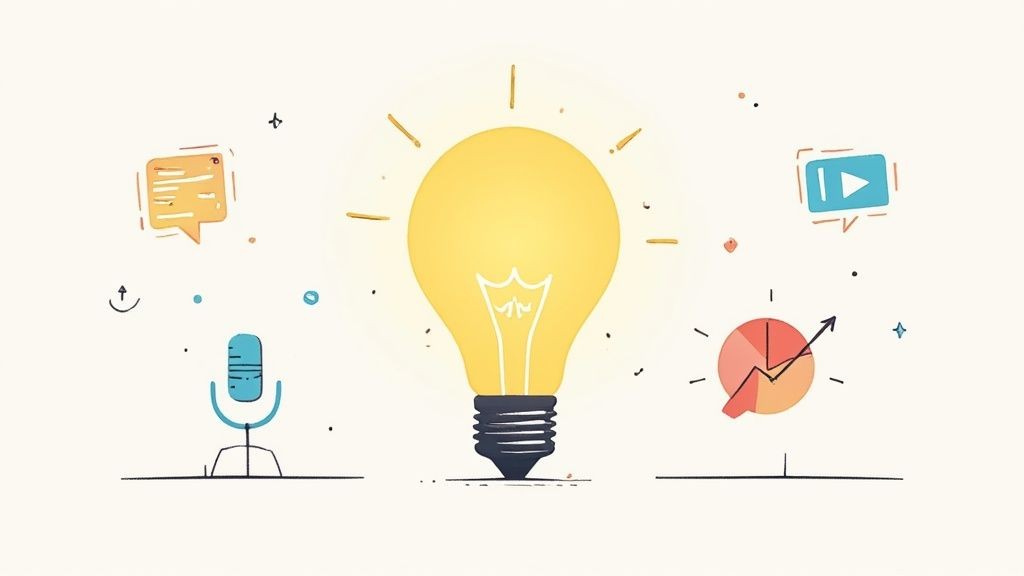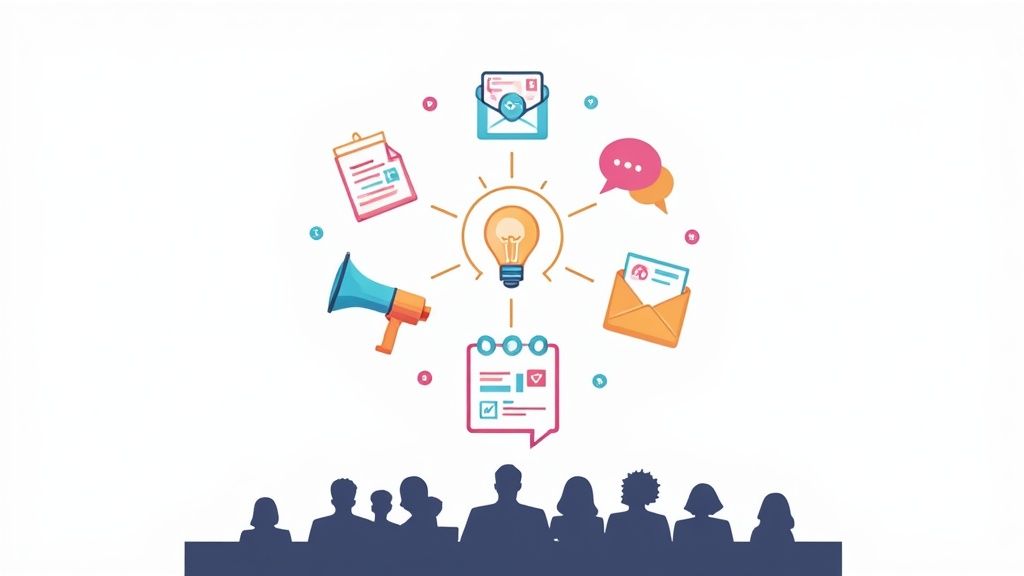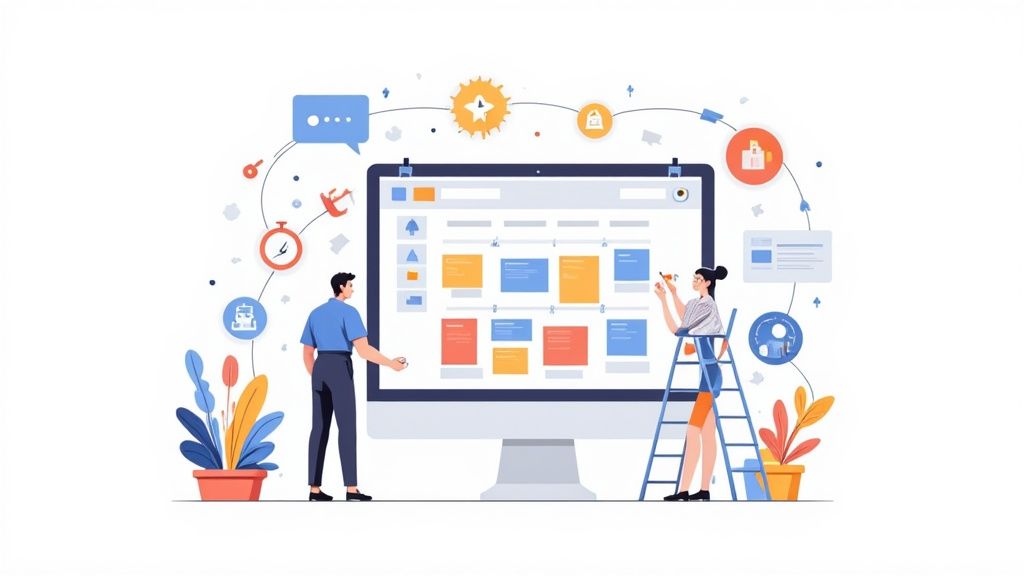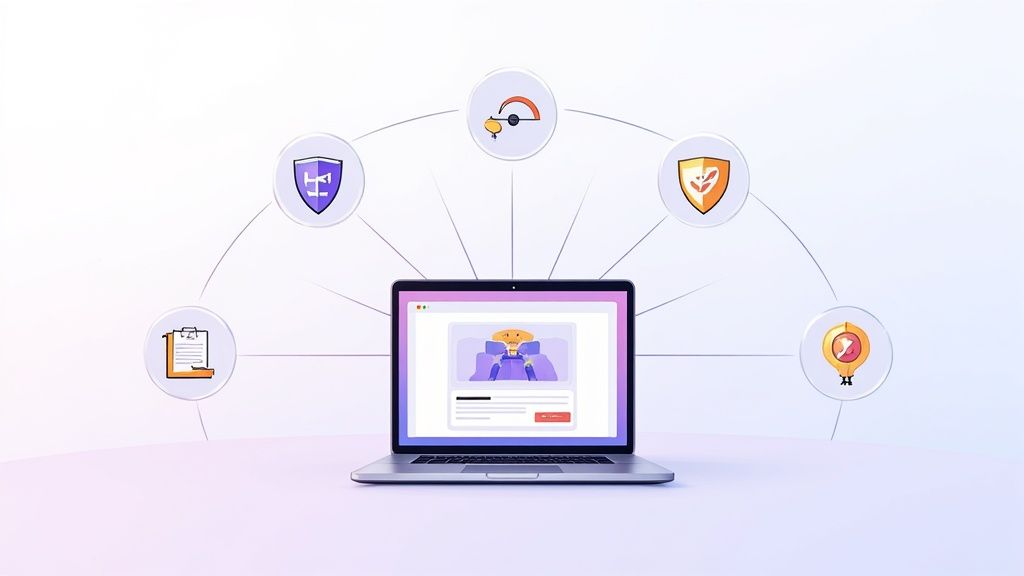Planning a conference is a monumental task, but the real challenge lies in filling the seats. Relying on outdated methods like basic email blasts and generic social posts is a recipe for empty rooms and missed opportunities. To capture attention and drive registrations, you need a multi-faceted approach that builds excitement, fosters community, and delivers undeniable value long before the event begins. A successful event requires a dynamic set of conference marketing strategies that work together to create an unmissable experience.
This article moves beyond the basics, unveiling 9 proven strategies that offer actionable insights to help you achieve a sold-out event. We will explore how to leverage everything from content and speakers to pricing psychology and powerful automation. You'll learn how to transform your marketing from a simple announcement into a compelling campaign that builds unstoppable momentum. This guide provides the specific tactics needed to turn your event from just another date on the calendar into a must-attend industry gathering. Let's dive into the strategies that will make your conference the talk of the town.
1. Content Marketing & Thought Leadership
Content marketing is one of the most powerful conference marketing strategies for building an audience long before you even announce a date. This approach focuses on creating and distributing valuable, relevant, and consistent content to attract and retain a clearly defined audience, ultimately driving registrations. By positioning your conference as a hub of industry expertise, you build trust and authority, making attendance a must for those who want to stay ahead.
Instead of directly selling tickets, you're offering solutions and insights. This establishes your event as the definitive source for industry knowledge, a place where genuine learning and connection happen. Think of HubSpot's INBOUND conference, which leverages its world-class blog and educational resources to create a massive, engaged audience eager to attend their annual event.

Why This Strategy Works
Content marketing builds a long-term relationship with your potential attendees. It transforms your event from a one-time transaction into a year-round community resource. This method is particularly effective for conferences aiming to become the premier event in their niche, as it demonstrates value and expertise well in advance.
How to Implement This Strategy
- Start Early: Begin your content efforts at least 6-12 months before the conference. This gives you ample time to build an organic audience and establish credibility.
- Focus on Pain Points: Create content that directly addresses the challenges and questions of your target audience. Think blog posts, research reports, webinars, and expert interviews that solve real problems.
- Leverage Speaker Expertise: Involve your confirmed speakers in content creation. This could be a guest blog post, a short video interview, or a Q&A session. This promotes your speakers while providing valuable content for your audience.
- Repurpose Everything: Turn a single research report into multiple blog posts, an infographic, a webinar, and a series of social media updates. This maximizes your reach without reinventing the wheel. You can explore a deeper dive into these tactics by reading our guide on event content marketing.
2. Speaker-Driven Marketing
Speaker-driven marketing transforms your most influential participants into powerful brand ambassadors. This conference marketing strategy leverages the personal brands, networks, and credibility of your speakers to amplify your event's reach far beyond your own channels. By empowering speakers to promote their sessions, you tap into highly engaged and relevant audiences who trust their recommendations.
This approach is about co-creation and mutual benefit. Your speakers gain visibility and reinforce their expert status, while your conference gains authentic endorsements from trusted industry voices. Think of how TED speakers enthusiastically share their upcoming talks; their personal promotion is a core part of the event's global appeal and reach.

Why This Strategy Works
This strategy builds on the foundation of trust. An endorsement from a respected industry leader is often more persuasive than a direct advertisement from the event organizer. It provides social proof and adds a layer of credibility that can significantly boost ticket sales, especially among niche professional communities who follow specific thought leaders.
How to Implement This Strategy
- Provide a Speaker Kit: Arm your speakers with a professional, easy-to-use promotional kit. Include official event logos, branded social media graphics, pre-written copy for posts, and key messaging points.
- Create Custom Promotional Assets: Generate speaker-specific landing pages and personalized discount codes. This not only makes them feel valued but also allows you to track which speakers are driving the most registrations.
- Encourage Early Promotion: Engage speakers in promotional activities as soon as they are confirmed. For instance, using our service, you can provide them with an "Add to Calendar" button for their specific session, which they can share on their websites or in their newsletters, ensuring their followers save the date directly.
- Offer Incentives: Consider a referral program that offers speakers a commission on ticket sales, a bonus, or enhanced visibility at the event for being top promoters. This gamifies the process and encourages active participation.
3. Community Building & Engagement
Building a community is one of the most sustainable conference marketing strategies because it transforms a one-time event into a year-round movement. This approach focuses on creating a space for like-minded professionals to connect, share, and learn, fostering a sense of belonging that makes your conference the community’s annual flagship gathering. By nurturing these relationships, you create a loyal base of advocates who feel personally invested in the event's success.
Instead of just marketing an event, you are cultivating an ecosystem. Salesforce’s Dreamforce is a prime example, built upon its vibrant Trailblazer community, where members engage and support each other throughout the year. This ongoing interaction ensures that the conference is not just an item on a calendar but a vital hub for the community it serves.

Why This Strategy Works
A strong community generates its own momentum. Members become your most powerful marketers through word-of-mouth and authentic testimonials. It creates a powerful feedback loop, allowing you to co-create an event that perfectly meets your audience's needs and desires, ensuring high satisfaction and retention rates year after year.
How to Implement This Strategy
- Start a Dedicated Hub: Create a space for your community to live, such as a Slack channel, a dedicated forum, or a LinkedIn group. This provides a central location for year-round conversations.
- Provide Exclusive Value: Offer community members early access to tickets, exclusive content, or opportunities to connect with speakers. This makes membership feel valuable and essential.
- Facilitate Peer-to-Peer Interaction: Design activities and discussion prompts that encourage members to talk to each other, not just listen to you. Focus on being a facilitator rather than a broadcaster.
- Use Feedback to Shape the Event: Actively solicit input from your community on topics, speakers, and formats. When attendees see their ideas implemented, it deepens their sense of ownership and loyalty.
4. Partnership & Sponsorship Leverage
Leveraging partnerships and sponsorships is one of the most effective conference marketing strategies for exponentially expanding your reach. This approach transforms your sponsors and partners from mere financial backers into powerful marketing channels. By creating mutually beneficial promotional agreements, you tap into their established networks, gain credibility through association, and access resources that would otherwise be out of reach.
This strategy is about co-creation, not just a logo placement. Think of how CES partners with major tech giants like Samsung and Google. These companies don't just sponsor; they integrate the event into their own massive product launch campaigns, creating a symbiotic marketing engine that benefits everyone. This turns a simple conference into an unmissable industry moment.

Why This Strategy Works
Partnership leverage is fundamentally about trust and reach. When a respected brand or organization promotes your conference, its audience is more likely to pay attention. It's a powerful form of social proof that validates your event's importance and quality. This strategy is ideal for conferences looking to quickly scale their audience, enter new market segments, or enhance their perceived value within an industry.
How to Implement This Strategy
- Create Tiered, Value-Driven Packages: Design sponsorship tiers with clear, compelling benefits beyond a logo on a banner. Offer speaking slots, co-branded content opportunities, or dedicated email blasts to their audience.
- Align Goals and Objectives: Work with partners to understand their marketing goals. Are they launching a new product? Recruiting talent? Align your promotional activities to help them succeed, ensuring they are motivated to promote the event heavily.
- Provide a Co-Marketing Toolkit: Make it easy for partners to promote you. Provide them with a toolkit containing pre-written social media posts, email copy, branded graphics, and unique tracking links.
- Track and Communicate Results: Regularly update your partners on the registrations and traffic they are driving. This demonstrates ROI and keeps them engaged in the promotional effort. For more ideas, you can explore our guide on how to get sponsorships for an event.
5. Early Bird & Tiered Pricing Psychology
Early bird and tiered pricing are classic conference marketing strategies that leverage human psychology to drive immediate action. This approach uses time-sensitive discounts and structured price increases to create urgency and reward decisive attendees. By offering a lower price for a limited time, you encourage potential attendees to commit early rather than procrastinate, securing a foundational block of registrations that builds momentum.
This strategy goes beyond simple discounts; it taps into the fear of missing out (FOMO) and the principle of scarcity. As each pricing tier sells out or a deadline passes, the perceived value of securing a ticket increases. Iconic events like SXSW and Comic-Con masterfully use progressive pricing models, where early commitment not only saves money but often grants access to exclusive perks, making the decision to buy now even more compelling.
Why This Strategy Works
This strategy is effective because it aligns with fundamental behavioral economics principles. It creates a clear incentive for early action, helping to smooth out the registration curve and avoid a last-minute rush. It provides early-stage revenue, builds social proof as tickets sell, and allows you to forecast attendance more accurately for better logistical planning.
How to Implement This Strategy
- Structure Your Tiers Logically: Create 3-4 distinct pricing tiers, such as "Super Early Bird," "Early Bird," and "Standard." Base the price jumps on past data or industry benchmarks to ensure they are significant enough to motivate action.
- Communicate Deadlines Clearly: Use countdown timers on your website and in emails to highlight when prices will increase. Send multiple reminders as each deadline approaches to maximize urgency.
- Offer More Than a Discount: Enhance the value for early purchasers. This could include exclusive access to a pre-conference workshop, a special networking session, or premium swag.
- Create Scarcity: Frame your offers around limited quantities in addition to deadlines. Phrases like "Only 100 Super Early Bird tickets available" can be more powerful than a simple date-based deadline.
6. Social Media & Hashtag Campaigns
A dynamic social media presence is non-negotiable for modern conference marketing. This strategy involves creating a powerful online buzz that starts months before the event, builds momentum through attendee engagement, and continues the conversation long after the closing keynote. By using strategic hashtag campaigns, you create a digital hub for all event-related conversations, making it easy for attendees to connect, share insights, and amplify your message.
This approach transforms passive followers into active participants and brand advocates. Think of how SXSW uses its iconic #SXSW hashtag not just for announcements, but to create a sprawling ecosystem of user-generated content, from session highlights to networking meetups. This makes the conference feel like a massive, shared experience both online and offline, driving immense FOMO (fear of missing out) and boosting future registrations.
Why This Strategy Works
Social media offers a direct line of communication with your audience, allowing you to build a community around your event. A well-executed hashtag campaign unifies all event-related content, increases visibility, and encourages user-generated content, which acts as authentic social proof. It's one of the most cost-effective conference marketing strategies for reaching a broad yet targeted audience.
How to Implement This Strategy
- Create a Unique Hashtag: Develop a short, memorable, and unique hashtag for your conference (e.g.,
#YourEvent2024). Promote it on all your marketing materials from day one. - Engage Proactively: Don't just post; engage. Respond to comments, re-share attendee posts, and feature user-generated content. Use social listening tools to monitor conversations and identify key influencers.
- Design for Sharing: Create visually appealing graphics, quote cards from speakers, and designated "photo op" areas at the venue. These shareable moments encourage attendees to post about their experience.
- Run Platform-Specific Campaigns: Tailor your content for each platform. Use Instagram Stories for behind-the-scenes glimpses, LinkedIn for professional insights and speaker announcements, and X (formerly Twitter) for live updates during the event.
7. Email Marketing Automation
Email marketing automation is a cornerstone of modern conference marketing strategies, allowing you to nurture leads and engage attendees with personalized, timely communication at scale. This approach moves beyond simple email blasts, creating a systematic journey that guides potential attendees from initial awareness to post-event engagement. By automating sequences based on user behavior, you ensure every touchpoint feels relevant and adds value.
Instead of manually sending every price update or speaker announcement, automation handles the heavy lifting, delivering the right message to the right person at the right time. Think of Dreamforce's comprehensive email journey, which masterfully guides subscribers with content tailored to their interests, session registrations, and engagement level. This systematic nurturing builds anticipation and keeps your event top of mind.
Why This Strategy Works
Email marketing automation creates a direct, personal line of communication with your audience. It excels at converting interest into registrations by consistently providing value and nudging subscribers along the decision-making process. This strategy is highly effective for maintaining momentum throughout a long promotional cycle, preventing your audience from going cold.
How to Implement This Strategy
- Segment Your Audience: Divide your email list based on factors like registration status (registered vs. not registered), interests (based on content downloaded), and past attendance. This allows for highly targeted messaging.
- Create Nurture Sequences: Develop automated email workflows for different segments. A common sequence is a "welcome series" for new subscribers or a "last chance" reminder for those who haven't purchased tickets.
- Provide Value, Not Just Pitches: Ensure your emails offer more than just sales messages. Share behind-the-scenes content, speaker interviews, or helpful tips related to your conference theme.
- A/B Test Everything: Continuously test subject lines, calls-to-action (CTAs), and send times to optimize open rates and conversions. Even small improvements can lead to significant registration boosts. You can find more practical advice in our guide to email marketing for events.
8. Referral & Affiliate Programs
Leveraging your existing audience is one of the most effective conference marketing strategies available. A referral or affiliate program transforms your attendees, speakers, and partners into an enthusiastic, motivated sales force. This approach incentivizes word-of-mouth marketing by offering rewards like ticket discounts, cash commissions, or VIP upgrades to anyone who successfully refers a new registrant.
This creates a powerful, scalable marketing engine built on trust. A recommendation from a peer is far more persuasive than a traditional ad. Think of Affiliate Summit, which grew exponentially by empowering its own network of affiliate marketers to promote the event, or Social Media Marketing World, which offers attractive rewards to advocates who spread the word. This strategy turns your event’s biggest fans into its most effective promoters.
Why This Strategy Works
Referral and affiliate marketing taps into the power of social proof and existing networks, often resulting in a lower cost-per-acquisition than paid advertising. It rewards loyalty and generates high-quality leads from trusted sources, creating a virtuous cycle where satisfied attendees bring in more attendees just like them.
How to Implement This Strategy
- Make It Simple and Trackable: Use a reliable system with unique referral links to make it easy for advocates to share and for you to track their success. Ensure the sign-up process for the program is straightforward.
- Offer Compelling Rewards: The incentive must be valuable enough to motivate action. This could be a percentage of the ticket price, a free ticket for a certain number of referrals, or exclusive access at the event.
- Equip Your Advocates: Provide your referrers with a toolkit of promotional materials, such as pre-written social media posts, email templates, and branded graphics to make sharing effortless.
- Communicate and Engage: Keep your affiliates engaged with regular updates on their performance, program news, and encouragement. A monthly newsletter can help maintain momentum and a sense of community.
9. Data-Driven Personalization & Retargeting
Data-driven personalization is a sophisticated conference marketing strategy that leverages attendee data and behavioral tracking to deliver highly relevant content and advertisements. Instead of a one-size-fits-all approach, this method segments your audience to create customized experiences, from targeted email campaigns about specific tracks to retargeting ads that remind interested visitors to complete their registration.
This level of detail makes potential attendees feel understood and valued. For example, Salesforce's Dreamforce conference uses attendee data to suggest personalized agendas and networking opportunities, while AWS re:Invent offers customized learning paths based on a user's role and interests. This transforms generic marketing into a helpful, guided journey, significantly boosting conversion rates.
Why This Strategy Works
Personalization cuts through the noise of generic event promotion. By showing potential attendees that you understand their specific professional needs and interests, you build a stronger connection and demonstrate the direct value your conference offers them. Retargeting keeps your event top-of-mind for warm leads who have already shown interest, making it one of the most cost-effective ways to recapture potentially lost registrations.
How to Implement This Strategy
- Segment Your Audience: Start by grouping your email lists and website visitors based on criteria like job title, industry, past event attendance, or specific pages they visited on your conference website.
- Use Retargeting Ads: Set up pixel-based retargeting campaigns on platforms like LinkedIn, Facebook, and Google. Show ads promoting a specific speaker or session track to users who visited those corresponding pages.
- Personalize Email Content: Go beyond using just a first name. Send targeted emails highlighting sessions relevant to a specific segment’s interests. For instance, send a "Marketing Track Preview" to everyone with a marketing-related job title.
- Ensure Data Privacy Compliance: Be transparent about the data you collect and ensure your practices comply with regulations like GDPR and CCPA. Always balance personalization with a deep respect for privacy.
Conference Marketing Strategies Comparison Table
| Strategy | Implementation Complexity 🔄 | Resource Requirements ⚡ | Expected Outcomes 📊 | Ideal Use Cases 💡 | Key Advantages ⭐ |
|---|---|---|---|---|---|
| Content Marketing & Thought Leadership | Medium - requires consistent content creation and expertise | Moderate - content creators, SEO tools | Long-term brand authority, organic leads | Building brand authority and organic engagement | Builds trust and SEO; cost-effective |
| Speaker-Driven Marketing | Low to Medium - coordination with speakers needed | Low - toolkit creation and management | Expanded reach via trusted voices | Amplifying promotion through industry experts | Authentic amplification; cost-effective |
| Community Building & Engagement | High - ongoing management and moderation | High - community platforms, moderators | Loyalty, repeat attendance, networking | Sustained engagement beyond event dates | Builds loyalty and user-generated content |
| Partnership & Sponsorship Leverage | Medium to High - partner coordination and messaging control | Moderate - negotiation and co-marketing | Extended reach, shared costs, additional revenue | Leveraging external networks and resources | Expands audience; shares costs; builds relationships |
| Early Bird & Tiered Pricing Psychology | Medium - complex pricing structure setup | Low to Moderate - pricing management | Early cash flow, urgency, revenue maximization | Driving early sales and maximizing revenue | Creates urgency; predicts attendance |
| Social Media & Hashtag Campaigns | Medium - requires constant monitoring and content creation | Moderate - content creation and social listening tools | Wide reach, engagement, viral potential | Buzz creation, real-time interaction | Cost-effective; real-time feedback |
| Email Marketing Automation | Medium - requires system setup and list management | Moderate - email platform and list maintenance | Scalable outreach, high ROI, personalized engagement | Nurturing leads and maintaining engagement | High ROI; personalized communication |
| Referral & Affiliate Programs | Medium - tracking and reward management | Moderate - referral system setup and rewards | Scalable word-of-mouth, high-quality leads | Incentivizing attendee and partner promotion | Trust-based leads; scalable |
| Data-Driven Personalization & Retargeting | High - technical setup and data management | High - data tools and analytics expertise | Higher conversion, better ROI, competitive advantage | Personalized marketing and retargeting campaigns | Increased relevance and ROI |
Putting Your Plan into Action
You now have a comprehensive toolkit of proven conference marketing strategies, from leveraging speaker influence and building a dedicated community to implementing sophisticated data-driven retargeting campaigns. We've explored how content marketing establishes your authority, how tiered pricing creates urgency, and how strategic partnerships can exponentially expand your reach. The journey from a great idea to a sold-out event is paved with these deliberate, interconnected actions.
The most critical takeaway is that these tactics are not a checklist to be completed in isolation. The true power of a successful marketing plan lies in its integration. Your email automation sequence should echo the messaging of your social media campaign. Your speakers should be armed with assets that align with your core content pillars. Your referral program should seamlessly complement your early bird pricing strategy. This synergy creates a powerful, multi-channel narrative that consistently reinforces your event's value proposition.
From Strategy to Execution
Building momentum is the name of the game. An effective promotional cycle doesn't start a month before the event; it begins the moment the previous one ends, or as soon as the next one is conceived. By weaving these strategies into a long-term plan, you transform your conference from a single point in time into a year-round brand experience. This sustained engagement keeps your audience warm, builds loyalty, and makes the final push for registrations far more effective.
Remember to focus on removing friction at every step of the user journey.
- Clarity is Key: Is your value proposition immediately clear on your landing page?
- Simplicity Wins: Is the registration process simple and mobile-friendly?
- Reminders Matter: Are you making it effortless for potential attendees to remember key dates and deadlines?
Simple, user-centric details can have an outsized impact on your conversion rates. This is where practical tools become indispensable. For instance, enabling attendees to add your event, registration deadlines, or speaker session reminders directly to their personal calendars with a single click is a small but mighty feature. It bridges the gap between initial interest and committed attendance, ensuring your conference stays top-of-mind amidst a sea of digital distractions. As you begin to implement these advanced conference marketing strategies, prioritize the ones that not only attract but also retain attention.
Ready to ensure your audience never misses a key date? Integrate our service into your event website and emails to provide a seamless way for attendees to save important deadlines. Start your free trial today and turn fleeting interest into confirmed attendance with our powerful, one-click calendar events. Add to Calendar PRO



